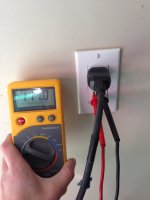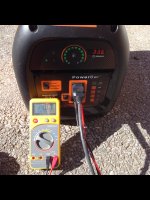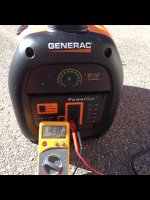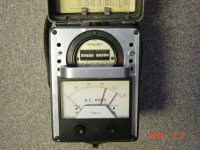Deere Dude
Elite Member
- Joined
- Feb 10, 2011
- Messages
- 4,014
- Tractor
- John Deere 3720
The most unbelievable thing about your whole story is that you had a furnace guy show up by 1 the same day during a major weather event! :laughing:

:laughing
The most unbelievable thing about your whole story is that you had a furnace guy show up by 1 the same day during a major weather event! :laughing:

Actually, the biggest issue I have with outages, is not the outage itself, but never knowing how long it will last.
Quiet is good. :thumbsup: Thanks for the tip on Honda Diesel.. I will have to keep my eyes open.In Washington the sound really carries... otherwise it is dead calm...
A few years back the condenser motor on the heat pump was going out and the noise really travels...
I like quiet and willing to pay extra for it.
One of the nicest gen-sets I have ever used was a Honda Diesel... really just a whisper... this was at least 20 years ago... don't think they have been sold here for a long time...
Hi Ron,At our age we do not do camping very well, even though we are rural area tree farmers, we like our creature comforts. Also like other posters we are at the end of an aging overhead power distribution and the last to get back up in the area. So, we have a 100A emergency panel w/ all essential loads in it. Only the outside stuff, range/oven, drier, and electric furnace are not covered. This spring/summer I am going to feed the furnace blower from the aux panel so air can be circulated from wood heat. I have a 17.5KW Generac that powers the 100A panel. It powers all very nice and never full loaded even with all the aux electric heat units and plug in portables working. Have a 1 KW UPS ahead of the computers and other electronic gear associated. With the fireplace insert stoked up we are almost normal. The genny burns about 15 GL (tank size) of gas every 12 hours at that loading. I use Staybil 360 Marine in the gas and have a 50 GL transfer tank. Next step is a propane conversion kit (this spring). i have accumulated two 38 GL motor home propane tanks for fuel and need to fab up a rack so I can move out for re-fill. It's cheaper to take tanks out for filing than a delivery service here.
Just another idea someone may be interested in. Ask questions.
I hate loud generators!!! Finally bought a Honda 3000is a few years back. Expensive but I love it. If I went bigger I would suck it up and pay for Honda. Don't know why I feel I have to sing the praises of Honda but I just do.
Is your neighbor on 'your' remote property? :confused3: I'm understanding you are using a long extension cord off your neighbor's generator. :laughing:You should hear my air cooled 6 HP Yamaha pull start diesel. I only use it on a remote property that does not have commercial power with a LONG extension cord. But if my neighbors get out of hand I may use at my house
Is your neighbor on 'your' remote property? :confused3: I'm understanding you are using a long extension cord off your neighbor's generator. :laughing:
Seriously I am getting interested in a diesel gen if they are as quiet as some say... diesel engine and quiet is an oxymoron in my book. What am I missing?
Hi Ron,
Good to hear from you... I am paying a penny or so under $2/gallon for LP here. Now that I own my own tank... got smart. I used to lease a big tank and that got me stuck with will overpriced fills... had to argue the $/gal each time. Back on topic, your 175.KW is almost 6 times the size of my 3K back up but dang, I cringed when I read your consumption rate.




I went outside and tested my Generac generator. It runs amazingly constant, but doesn't handle high start up loads well. It runs with about 1 volt either way of variation which is pretty darn good for a generator. It puts out about 123 volts under no load. Under 80% load which was a 1500 watt heat gun it maintains about 119 volts. My house outlets maintained 117 volts with the same load and about 125 volts under no load. What kills the electronics was start up voltage. The generator dropped to about 110 volts by unplugging and plugging the heat gun up. That is acceptable, so I decided to try a miter saw. This miter saw was rated to pull 10 amps, but start up must have been much greater. My generator is rated to produce a tad over 13 amps continues. Starting the miter saw dropped the generator down to about 40 volts. After about 3 attempts to start it it tripped the overload on the generator. I have a cheap, extremely loud 3,500 watt generator that I'm going to test later. The miter saw dropped the house outlet down to about 100 volts. We recently ran the house for about 5 days with a 8,000 watt welder/generator that had about 10 volts variation. It was loud and very thirsty.
View attachment 453609
View attachment 453610
View attachment 453611
I have a whole house 22,000 watt natural gas powered generator. If that doesn't keep up I'm doing something wrong.,Older consumer level generators used to come with Tables in the Owner's Manual, that gave listings of typical motor Running watts and Starting watts. Startup takes way more power than many people realize. In an extended outage, the odds keep creeping up that with a fridge, sump pump, freezer.... connected, you may have a chance alignment where more than one motor tries to start at the same time. Makes upsizing a gen or a solution like 90cummins is using attractive (4kw inverter w. Gen assist). IMO any well designed consumer product should be able to handle short-term brownouts (a reality with some grid connections too), but it's nothing I like to push my luck on - I bought a 7kw gen last time. Size up your loads, add at least 25%, then buy the quietest generator that fits your budget is what I suggest to real-world friends. Rgds, D.